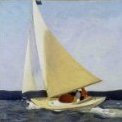Supplies of the Ship Modeler's Handbook are running out. Get your copy NOW before they are gone! Click on photo to order.
×
-
Posts
841 -
Joined
-
Last visited
Reputation Activity
-
 michaelpsutton2 got a reaction from tasmanian in Skylights and sailing ships
michaelpsutton2 got a reaction from tasmanian in Skylights and sailing ships
Good morning The armed virginia sloop was of a type generally known as a "Bermuda Sloop" Chapman has an example in his Architectura Navalis Mercatoria. There are any number of other contemporary illustrations form the period. None show any structures on the deck at all. The decks are rather steeply crowned and even the tillers are underneath. Most small ship designs would have been steered from a position with better visibility .
I have a small bit of sailing experience, no real blue water" but the design makes me think it was designed to shed water and shield the helmsman if overtaken by a following sea.
-
 michaelpsutton2 got a reaction from fnkershner in Skylights and sailing ships
michaelpsutton2 got a reaction from fnkershner in Skylights and sailing ships
Good morning The armed virginia sloop was of a type generally known as a "Bermuda Sloop" Chapman has an example in his Architectura Navalis Mercatoria. There are any number of other contemporary illustrations form the period. None show any structures on the deck at all. The decks are rather steeply crowned and even the tillers are underneath. Most small ship designs would have been steered from a position with better visibility .
I have a small bit of sailing experience, no real blue water" but the design makes me think it was designed to shed water and shield the helmsman if overtaken by a following sea.
-
 michaelpsutton2 got a reaction from Jay 1 in Breast stays
michaelpsutton2 got a reaction from Jay 1 in Breast stays
The breast back stays were "abreast the mast. Or in laymen's terms directly on either side of the mast. They were rigged from the topmast with a block and fall hooked to an eye set on the channel. The eye bolt should be as close as possible to the centerline of the mast but aft of the first shroud. The eye is set outboard of the deadeyes for the shrouds. The fall belays to the pinrail inside of the shrouds. In practice I believe that only the weather breast back stay would be taught. The lee would be slack. I have read where in harbor the breast back stays could function as lifts for the boat booms. Smaller vessels would have single blocks Larger would have double.
-
 michaelpsutton2 got a reaction from trippwj in Question on the rigging of the Mainsail of a Brigantine
michaelpsutton2 got a reaction from trippwj in Question on the rigging of the Mainsail of a Brigantine
Here is an English "snow from the 1750's. The difference between a snow and a brig is that the snow has a small pole or mast just aft of the main mast. It stands on the deck and is secured under the main top. The driver or later spanker is laced to this smaller pole instead of the main mast itself. The sail is shown brailed to the gaff & mast. There is no boom. It appears as was often the custom, the same vessel is shown from the stern sailing away from the viewer. It can be seen that the driver/spanker is not extended past the stern with a boom as was common beginning in the 1780's.
-
 michaelpsutton2 got a reaction from trippwj in Question on the rigging of the Mainsail of a Brigantine
michaelpsutton2 got a reaction from trippwj in Question on the rigging of the Mainsail of a Brigantine
Here is an English brigantine painted by John Cleverly in 1757. There is a lanteen yard instead of a gaff with a full mizzen sail. This sail is brailed up to the yard and the yard is lowered. French practice could have been different.
-
 michaelpsutton2 got a reaction from SailingRabbit in Question on the rigging of the Mainsail of a Brigantine
michaelpsutton2 got a reaction from SailingRabbit in Question on the rigging of the Mainsail of a Brigantine
I am only familiar with English practice, but In the 1740's there was a substantial chance that there would not have been a boom and the sail was loose footed. Although the gaff could indeed be lowered the sail would have been laced to the mast and brailed up similar to your diagram.
-
 michaelpsutton2 got a reaction from SailingRabbit in Question on the rigging of the Mainsail of a Brigantine
michaelpsutton2 got a reaction from SailingRabbit in Question on the rigging of the Mainsail of a Brigantine
Here is an English brigantine painted by John Cleverly in 1757. There is a lanteen yard instead of a gaff with a full mizzen sail. This sail is brailed up to the yard and the yard is lowered. French practice could have been different.
-
 michaelpsutton2 got a reaction from flying_dutchman2 in The Ships of Abel Tasman
michaelpsutton2 got a reaction from flying_dutchman2 in The Ships of Abel Tasman
My local library got this one for me. Don't just use the catalog. My local (Mandeville,Louisiana) library can borrow almost anything I need from as far away as the Library of Congress
-
 michaelpsutton2 got a reaction from Jay 1 in Gun port lids and sweeps, on small vessels
michaelpsutton2 got a reaction from Jay 1 in Gun port lids and sweeps, on small vessels
My compliments to Jmaitri for a very thought provoking comment. I consider my self to be a good researcher and his "fallacy of authority" concept is as neatly phrased as any I have seen,
Please teach me about sweep ports.
On the draughts they are mostly square (pleae note I never use the forbidden word ALL). There are a few that are round with a slot to pass the blade of the sweep.
Do they pierce a frame or are they situated between frames with short lintels above and below like ports?
Were they the same size in the inboard and outboard sides?
What was it like, attempting to row with a round peg inserted in a square hole through a bulkwark as much as a foot thick? Were there some kind of fitting in the sweep ports to make them a little more oar friendly. If I were a designer I would tend to make my sweep ports shaped like a truncated cone with the small end inboard.
Lastly I have seen some models with lids on the sweep ports, but mostly when these ports were placed below the weather deck
-
 michaelpsutton2 got a reaction from DORIS in ROYAL CAROLINE 1749 by Doris - 1:40 - CARD
michaelpsutton2 got a reaction from DORIS in ROYAL CAROLINE 1749 by Doris - 1:40 - CARD
Just astounding. I am going to pitch all my tools in the ditch out front and take up whistling or something
-
 michaelpsutton2 got a reaction from Roman in HBMS Amphion 1798 by Matrim - 32 Gun 18pdr Frigate
michaelpsutton2 got a reaction from Roman in HBMS Amphion 1798 by Matrim - 32 Gun 18pdr Frigate
I would like to address the question of gunports directly above each other.
I have never seen a draught which placed the gunports on a dedicated "gundeck" directly in line with the ports of an adjacent dech. But beginning about 1660 or so the ports on a quarter or poop deck could be arranged without regards to the ports on the gundecks below.
There is frequent reference to the portson the quarterdeck being crowded together to reach the "rated" total. Look at the famous model of the HMS Sussex in the US Naval Academy Museum or the HMS Prince (1670) in the Scince Museum collection
Later in the 19th century as frigate quarter decks began to be rearmed with carronades the ports would be distributed without taking the ports on the gundeck into consideration. As an example the famous sail plan of the USS Constitution (C&R 27-15-18) as opposed to any of her seceral design draughts.
I would also caution you to measure carefully. The "minor ports" are not always evenly spaced.
-
 michaelpsutton2 got a reaction from Stockholm tar in HMC Sherbourne 1763 by Hollander-jan - Caldercraft - 1/64
michaelpsutton2 got a reaction from Stockholm tar in HMC Sherbourne 1763 by Hollander-jan - Caldercraft - 1/64
I looked last night and although offset rudders make their appearance on draights at the NMM about 1750, they do not become common until after 1800.
-
 michaelpsutton2 got a reaction from Gregor in HMC Sherbourne 1763 by Hollander-jan - Caldercraft - 1/64
michaelpsutton2 got a reaction from Gregor in HMC Sherbourne 1763 by Hollander-jan - Caldercraft - 1/64
I see a good many draughts which have the rudder a tad higher than the bottome of the keel. The idea was to avoid damaging the rudder if the ship grounded. Sometimes the difference was just the thickness of the false keel or shoe. Sometimes the foot of the rudder sloped up as it went aft.
I call your attention to the model of the cutter #SLR0519 in the National Maritime Museum or the draughts ZAZ6490 unamed cutter, ZAZ6425 Racer, ZAZ6274 Curlew, and ZAZ6343 the Pitt of 1763 all have the rudder offset from the keel.
The Berwick a storeship of 1781 (ZAZ5405) has a rudder that slopes up as it runs aft
On the other hand ZAZ6344 Fly, Zaz6498 and others show the rudder even with the bottom of the keel.
So in the absence of any definitive info on the Sherbourne you could have it either way
I would whole heartedly agree with Stockholm tar that the gap at the post is too large and would create drag
Keep the pic's coming! It's looking better and better
-
 michaelpsutton2 got a reaction from tkay11 in HMC Sherbourne 1763 by Hollander-jan - Caldercraft - 1/64
michaelpsutton2 got a reaction from tkay11 in HMC Sherbourne 1763 by Hollander-jan - Caldercraft - 1/64
I see a good many draughts which have the rudder a tad higher than the bottome of the keel. The idea was to avoid damaging the rudder if the ship grounded. Sometimes the difference was just the thickness of the false keel or shoe. Sometimes the foot of the rudder sloped up as it went aft.
I call your attention to the model of the cutter #SLR0519 in the National Maritime Museum or the draughts ZAZ6490 unamed cutter, ZAZ6425 Racer, ZAZ6274 Curlew, and ZAZ6343 the Pitt of 1763 all have the rudder offset from the keel.
The Berwick a storeship of 1781 (ZAZ5405) has a rudder that slopes up as it runs aft
On the other hand ZAZ6344 Fly, Zaz6498 and others show the rudder even with the bottom of the keel.
So in the absence of any definitive info on the Sherbourne you could have it either way
I would whole heartedly agree with Stockholm tar that the gap at the post is too large and would create drag
Keep the pic's coming! It's looking better and better
-
 michaelpsutton2 reacted to amateur in HMC Sherbourne 1763 by Hollander-jan - Caldercraft - 1/64
michaelpsutton2 reacted to amateur in HMC Sherbourne 1763 by Hollander-jan - Caldercraft - 1/64
Nice repair. Not many people will notice.
With respect to the Batavia-gun: yes the guncarriage is rather high.
It is a solution to a problem the Dutch (and probably some others too) created.
In early shipbuilding decks followed the sheer of the whales, (leading to gunports all around the same distance above the deck, but quite sloping decks)
Then they startted to reduce the slope of the deck, but they didn't dare to cut the gunports thtough the main wales, resulting i an uneven distance of the gunports to the deck.
Finally, they started to cut through the wales, leading to rather flat decks, and a more or less equal distance between gunport sills and the deck.
The reconstruction of Batavia is build with almost flat decks, and a very heavy sheer of the wales. (perhaps even overdoing both too much, who knows)
Therefore, the guns towards the aft part of the ship (which you are looking at here) need relatively high carriages.
Jan
-
 michaelpsutton2 got a reaction from Mirabell61 in Heinrich Kayser 1898 by Nils Langemann - FINISHED - scale 1:96 - as she appeared in 1922
michaelpsutton2 got a reaction from Mirabell61 in Heinrich Kayser 1898 by Nils Langemann - FINISHED - scale 1:96 - as she appeared in 1922
How do you make those spherical ventalators?
-
 michaelpsutton2 got a reaction from WackoWolf in HBMS Amphion 1798 by Matrim - 32 Gun 18pdr Frigate
michaelpsutton2 got a reaction from WackoWolf in HBMS Amphion 1798 by Matrim - 32 Gun 18pdr Frigate
I would like to address the question of gunports directly above each other.
I have never seen a draught which placed the gunports on a dedicated "gundeck" directly in line with the ports of an adjacent dech. But beginning about 1660 or so the ports on a quarter or poop deck could be arranged without regards to the ports on the gundecks below.
There is frequent reference to the portson the quarterdeck being crowded together to reach the "rated" total. Look at the famous model of the HMS Sussex in the US Naval Academy Museum or the HMS Prince (1670) in the Scince Museum collection
Later in the 19th century as frigate quarter decks began to be rearmed with carronades the ports would be distributed without taking the ports on the gundeck into consideration. As an example the famous sail plan of the USS Constitution (C&R 27-15-18) as opposed to any of her seceral design draughts.
I would also caution you to measure carefully. The "minor ports" are not always evenly spaced.
-
 michaelpsutton2 got a reaction from flying_dutchman2 in Latest Rif Winfield book available for pre-order
michaelpsutton2 got a reaction from flying_dutchman2 in Latest Rif Winfield book available for pre-order
I'll give you $100 for your copy right now!
This morning on Amazon.com New $4128.88 Used $2002.39. I am asuming they did not print as many as the others. I can't imagine that it is because that one is so much more interesting
I better buy the used one. It looks like a bargain
-
 michaelpsutton2 got a reaction from trippwj in Latest Rif Winfield book available for pre-order
michaelpsutton2 got a reaction from trippwj in Latest Rif Winfield book available for pre-order
I'll give you $100 for your copy right now!
This morning on Amazon.com New $4128.88 Used $2002.39. I am asuming they did not print as many as the others. I can't imagine that it is because that one is so much more interesting
I better buy the used one. It looks like a bargain
-
 michaelpsutton2 got a reaction from trippwj in Latest Rif Winfield book available for pre-order
michaelpsutton2 got a reaction from trippwj in Latest Rif Winfield book available for pre-order
The latest and, I guess, finalt volume in Rif Winfield's series on the British Navy is available for pre-order.
"British Warships in the Age of Sail 1817-1863" is on Seaforth Publishing's website.
I have the first two volumes but for some strange reason the price on Volume 3 "1792-1817" is in the thousands of dollars. So I am getting an order in early for Volume 4.
Although I do wonder if there is much new material not found in the Sail & Steam Navy by David Lyon
-
 michaelpsutton2 got a reaction from granta in Cruizer-class Brig-Sloops of the Royal Navy
michaelpsutton2 got a reaction from granta in Cruizer-class Brig-Sloops of the Royal Navy
It is singularly unforgiving.
It is the moment just before the pen touches the pen touches the board for the first time that is so addictive. At that moment I just know this painting is going to be perfect. Once I begin, each brush stroke is a kind of compromise. And in the end my own limitations force me to have to continue the quest for the ultimate work from the beginning all over again.
Last night I began an illustration of HMS Rose 1757 based on the original draughts not on the replica now in existance and iI told myself as I sat in front of that prisine white canvas that just maybe, God willing and a fair wind, this will be the one.













